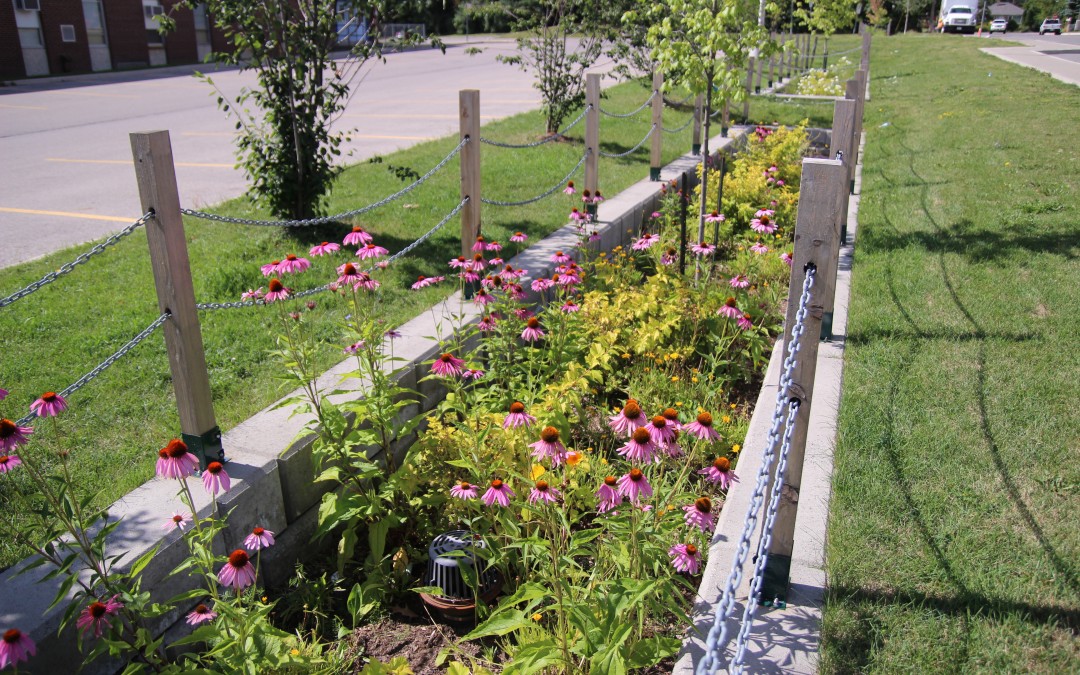Photo: Bioretention planters along the road rights-of-way at Elm Drive, Mississauga, ON, by Credit Valley Conservation.
During an impending snowstorm last March people piled into Clarke Memorial Hall in Port Credit, Ontario. They were attending a sold-out event to discuss opportunities for managing rainfall in rights-of-way. The key note speaker was Robert Goo from the Environmental Protection Agency in Washington, D.C. A true visionary with real-world experience. Robert celebrated green streets as multi-functional and central to building better communities—with stormwater capture as only one aspect.
Due to the overwhelming success of his previous presentation, Green Communities Canada will be hosting a webinar entitled Roads and Runoff: using green infrastructure to manage stormwater runoff from roads and highways with Robert Goo on 23 November, 1-2pm EST. During this webinar Goo will discuss what the US EPA has done to enhance right of ways by using green stormwater infrastructure and the resulting benefits of creating green streets. This is the last webinar in the Soak it Up! Fall 2016 Webinar Series. Learn more and register online.
A large proportion of the hard surfaces that make up the urban landscape include parking lots, roads and driveways. In Ontario, there are nearly 200,000 km of roadways creating over 1,100km² of impervious surface – that’s an area greater than the entire city of Toronto! Twenty-five millimeters of rainfall across the province generates over 25 billion litres of stormwater runoff, and millions of kilograms of pollution that runs directly into local watersheds.
Managing road runoff through rain gardens, bioswales, infiltration galleries, or urban trees in the rights-of-way reduces stormwater volumes and stormwater pollution. These practices also make streets safer and more pleasant for pedestrians and cyclists, while sequestering carbon. These features are variously referred to as green infrastructure and/or Low-Impact-Development (LID).
Momentum for introducing green infrastructure into the construction and reconstruction of roadways in Ontario is slowly increasing. Credit Valley Conservation released have released a manual Grey to Green Road Retrofits: Optimizing your Infrastructure Assets Through Low Impact Development. The City of Toronto will soon be releasing Green Street Technical Guidelines, which will help ingrain green infrastructure into street design practices.
Innovative projects like The Bentway (formerly known as Project: Under Gardiner) are transforming vacant, impervious spaces in the urban core into vegetated community hubs that capture runoff. The Bentway’s 1.75 km retrofit will change the Gardiner Expressway’s previously abandoned underbelly into a trail and public space. It offers opportunities to manage rain where it falls, treating and infiltrating the water that runs off one of Ontario’s most used highway stretches.
Projects in the U.S. continue to serve as a source of inspiration and model best practices. The Southeast Atlanta Green Infrastructure Initiative features six miles of permeable pavers — the largest permeable paver project in North America. These surfaces will intercept, detain, and slowly release rain that falls on the roadway and adjacent sidewalks.
On the US west coast, an innovative stormwater treatment system playfully called the Swale on Yale consists of four biofiltration swales, a pre-treatment system, and a diversion structure. It is being designed to treat 190 million gallons of water annually. The swale will slow the rainwater, infiltrate it, and remove pollutants improving water quality in the local lake and reducing flood risk in the surrounding neighbourhood.
Infiltrating stormwater in rights-of-way still has a long way to go before it is the norm in Canada. There are a number of barriers that contribute to this including lack of capacity, concerns about pollution and the impacts on groundwater, competing interests for limited space in rights-of-way, maintenance concerns, provincial and municipal standards and funding. But there are plenty of reasons why we need to start overcoming these barriers. The Credit Valley Conservation has produced a number of case studies detailing road right-of-way low impact development projects, and has found that costs are consistently lower than expected and performance has exceeded expectations.
However, despite the demonstrated benefits and growing interest in greening streets, infiltrating stormwater in the rights-of-way is still not the norm in most Canadian cities. There are many perceived and real barriers that we face within our communities. We hope that learning from experts such as Robert Goo will help to provide the inspiration we need to start finding solutions to address these barriers.
This blog was published on the Umbrella Stormwater Bulletin Issue 50.

